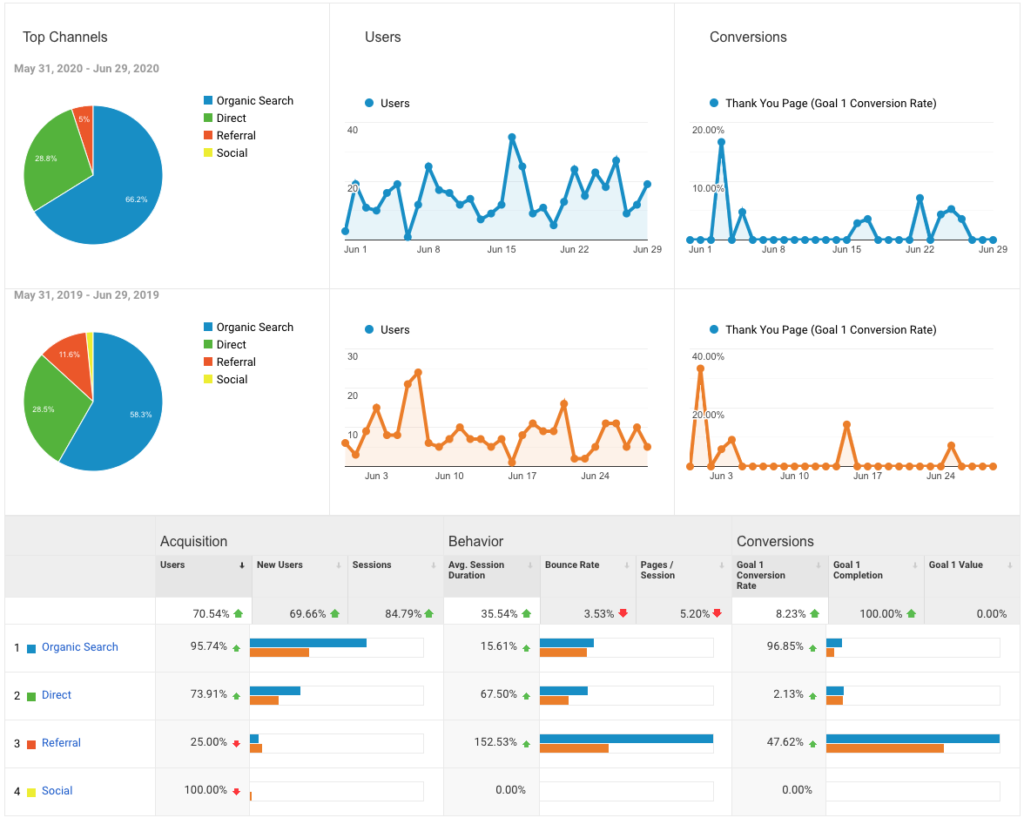When it comes to SEO (search engine optimization), your mileage will vary depending on your industry. As you might expect, the legal industry tends to be very competitive. As a result, law firm websites may have to put in a little more effort before the needle starts moving.
Have no doubt, though. Even if your SEO takes a little longer to kick in – anywhere from 3 to 6 months – it’s an investment you want to make the sooner the better. The best time to have started SEO content marketing was yesterday. The second best time is now.
You may have seen examples of websites in other industries seeing dramatic SEO improvements. Unless you’re practicing in a super niche area with low keyword competition, your law firm website may realistically see more gradual increases in SEO performance over time.
This case study shows how in just 1 year, I helped one law firm nearly double its website’s organic search engine traffic and quadruple the number of client inquiries from those visitors. This involved no paid advertising, backlink building, or social media campaigns.


This SEO campaign did more than just improve my client’s search engine rankings. It also got my client’s website to appear in Google’s highly sought-after “featured snippet” search results.

Once your page starts ranking high enough to hit Google page 1, especially the top of the page, it’s hard to get knocked back down to page 2. You’ll get more backlinks simply from being the highest authority on a subject. Plus, SEO equity can get passed around your entire website. The higher your individual pages rank, the higher your website will rank as a whole.
You can check your website’s overall domain authority for free with Domain Analyzer by Moz, a leading SEO company and resource.
How to Improve Law Firm SEO with Content
My client is a small law firm operating in a high-competition practice area in a mid-sized city. We started by publishing a couple of blog posts per month, targeting specific types of client cases.
After a few months, my client wanted to expand their website to cover their new area of practice. We planned 30,000 words of content for their new practice area pages, each page coming in at anywhere from 1,500 to 8,000 words to rank well in their market. We also created a couple of targeted landing pages.
During this time, I completed an in-depth website and SEO audit for my client. I updated their WordPress installation and plugins, created automatic backups, secured their site, and optimized their website’s technical settings for the best SEO performance.

Analytics may be all about data, but the numbers always tell a human story. This Active Uses Report shows the number of visitors going up between June and October as I started executing our SEO campaign. In December, my client took a break from posting – you can see the slight dip in January. (Also, the holidays tend to be slow for law firms in general.)
Early in 2020, my client’s website got a redesign. I rewrote the homepage and optimized the meta titles and descriptions for all published pages. In February we resumed publishing new blog posts and started publishing the new practice area pages we’d been developing. You can see the fruits of our efforts in the steadily increasing number of visitors since January.
Not only that, but the quality of visitors improved, too, as seen by the increase in contact form submissions.
Click here for answers to the most frequently asked questions about legal content and SEO.
Matching SEO Keywords to the Right User Intent
Organic visitors tend to be the most valuable because they’re much more likely to convert to client calls. But not all organic visitors have the same value. You want to make sure to target keywords that match the right user intent, otherwise your content will miss the mark.
For example: If you’re a divorce attorney, you want to target keywords that people would actually search for if they’re considering divorce for themselves.
You might write an amazing article based on the keyword “divorce statistics” or “divorce statutes” but the people searching for those keywords are probably looking just to learn something, not hire a lawyer. So if they click on your page in search results and your page doesn’t match their expectations or needs, they’re going to leave quickly.
This decreases your average session duration and increases your bounce rate. Bounce rate refers to the number of people who leave your website after looking at only one page. If your bounce rate is really high, Google’s going to think people aren’t finding what they’re looking for on your website, and that will hurt your rankings.
Instead of a mismatched keyword, it’s much better for a divorce attorney to target long-tail keywords like “how much does a divorce cost.” When people search for this phrase, you can reasonably assume that they’re considering hiring a divorce lawyer. These are the high-intent potential clients that you want to attract.
Looking at this website’s overall user data, you can tell by people’s behavior that the new content is targeting the right type of visitors.

In addition to nearly:
- Doubling the number of visitors from search engines,
- Doubling the goal conversion rate, and
- Converting 4 times more contact form submissions from organic visitors,
Visitors also spent longer amounts of time on this website (see Average Session Duration).
From Google’s point of view, a longer average session duration means visitors found the content informative and valuable. This, in turn, raises your website’s search engine rankings.
The number of return users increased as well (see Number of Sessions per User). When visitors return, it’s another sign to Google that people find valuable content on this website.
All of these add up to better SEO momentum over time, especially if you continue to put out good content. Even a single blog post per month can make a difference.
Click here to learn more about how to target the right keywords to get more clients.
A Comprehensive SEO Strategy Includes Internal Links
Internal links are a free and easy way to distribute SEO equity throughout more pages of your website. They should absolutely be a part of your SEO strategy.
Before I started writing any new practice area pages, I created a content outline. The outline included plans for internal linking between related pages. Outlining your content strategy beforehand allows you to optimize your pages for the best performance.
Not only that, but I realized we’d published several blog posts about a specific type of law that didn’t have a practice area page yet. So we prioritized a content page for those types of cases. Once that page was also published, I connected all of the related content with internal links.
What’s the strategy here and why are we doing any of this?
Let’s say that you want to represent clients in certain types of class action cases. You write a blog post covering the class action well enough to rank on Google page 1.
People who are searching for information about the class action lawsuit will see your page. They click on your post and read your informative content, where you encourage them to contact you for legal help. From that page, you also direct your visitors to a practice area page where they can read more about class action cases.
The more they learn, the more they appreciate your approachable and useful content. You’ve demonstrated your expertise and put potential clients at ease about the legal process. Who wouldn’t want to pick up the phone and call you for help?
SEO is all about the long game – building a foundation of long-term growth for your law firm. Its benefits are well-established in the online marketing world. You could throw your money at lead services or pay-per-click advertising every month, competing with firms that have much deeper pockets than you. In the end, you stop benefiting from these services the moment you stop paying for them.
But content keeps paying off over time. You will always have the high-quality content that you publish on your website. Any additional content only builds on what you already have. The more content-rich and well-established your website, the better your domain authority and the better your search engine rankings.
Unlike ads or lead services where you have nothing to show for your investment, you own your content. You get to control the quality of the leads you attract.
SEO Strategy Moving Forward
I look forward to seeing how this website continues to grow in the next year. We have more practice area pages to complete and more blog posts to cover relevant cases. Plus, this year we will also work on building more backlinks for even higher domain authority.
Click here to read more about what hiring a legal content writer can do for you. If you’d like to chat about what SEO can do for your law firm, contact me using this form or email me now.
